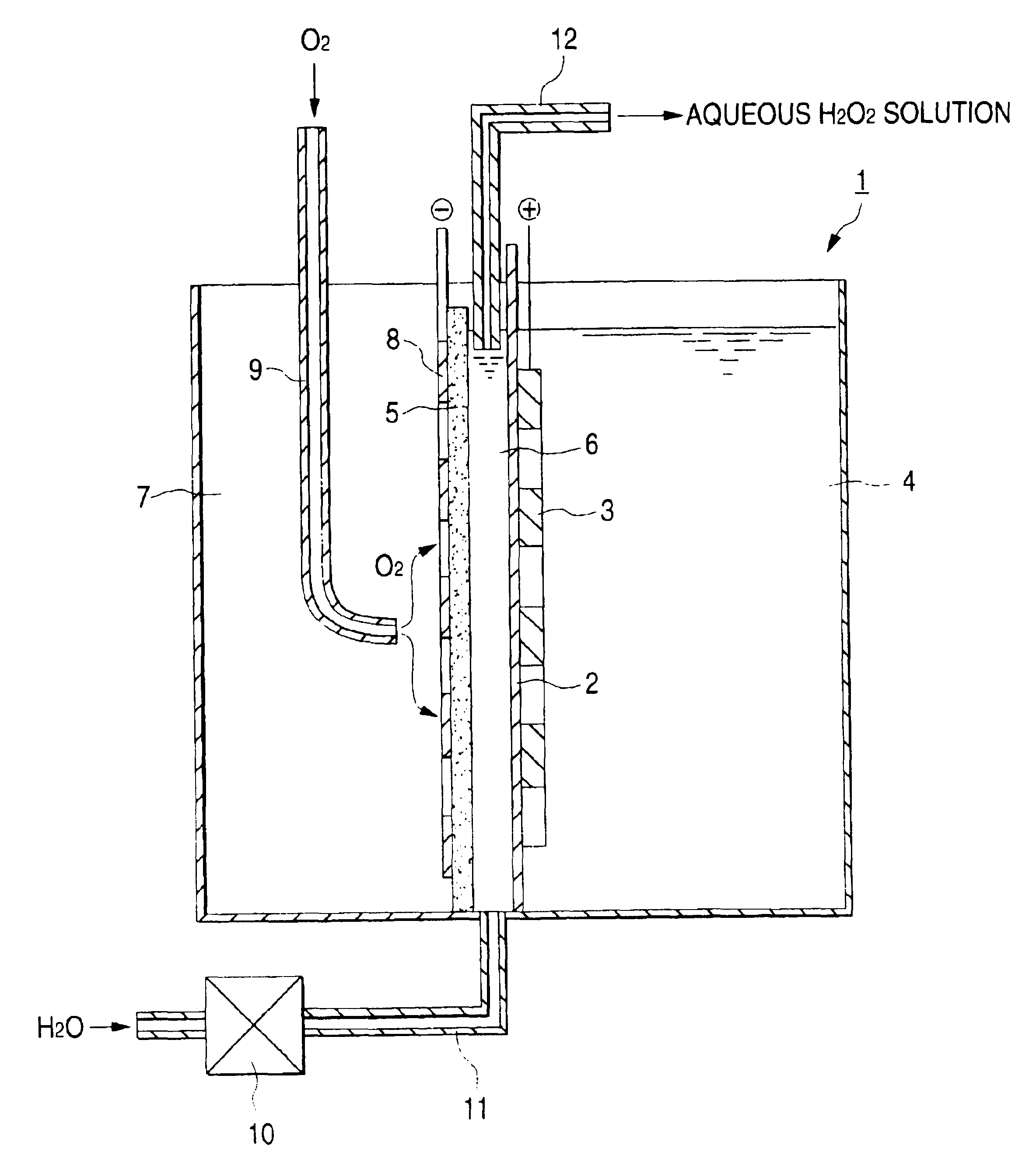Electrolytic cell for hydrogen peroxide production and process for producing hydrogen peroxide
a technology of hydrogen peroxide and electrolysis cell, which is applied in the direction of electrolysis components, chemistry apparatus and processes, water/sludge/sewage treatment, etc., can solve the problems of untreated hypochlorous acid, adversely affecting the ecosystem, and affecting environmental conservation
- Summary
- Abstract
- Description
- Claims
- Application Information
AI Technical Summary
Benefits of technology
Problems solved by technology
Method used
Image
Examples
example 1
An iridium oxide catalyst was deposited onto a porous titanium plate by a pyrolytic method in an amount of 10 g / m.sup.2 to obtain an anode.
A graphite powder (TGP-2, manufactured by Tokai Carbon Co., Ltd.) was kneaded together with a PTFE resin. The resultant mixture was formed into a sheet and burned at 330.degree. C. to obtain a 0.5 mm-thick sheet. This sheet as an oxygen gas diffusion cathode was united with a cathode feeder consisting of a porous graphite plate having a thickness of 5 mm.
The anode was placed into intimate contact with an ion-exchange membrane (Nafion 117, manufactured by E.I. du Pont de Nemours & Co.). The feeder-bearing oxygen gas diffusion cathode was disposed so as to result in an electrode spacing of 3 mm to fabricate an electrolytic cell having the structure shown in the FIGURE which had a height of 25 cm and an area effective for electrolysis of 125 cm.sup.2.
On the other hand, tap water was softened with an ion-exchange membrane, and sodium sulfate was diss...
example 2
An electrolytic cell was fabricated under the same conditions as in Example 1, except that the ion-exchange membrane was omitted. While the aqueous sodium sulfate solution prepared in Example 1 continued to be supplied to the electrolytic cell (to the region corresponding to the anode chamber and solution chamber in Example 1) at a rate of 20 ml / min, a current of 6.3 A was passed through the electrolytic cell at a temperature of 25.degree. C. As a result, the cell voltage was 12 V and an aqueous hydrogen peroxide solution having a hydrogen peroxide concentration of about 2,500 ppm was obtained through the outlet from the electrolytic cell at a current efficiency of about 40%.
This electrolytic production of hydrogen peroxide was continued for 6,000 hours. As a result, the current efficiency and the hydrogen peroxide concentration decreased to about 30% and about 2,000 ppm, respectively. However, the operation could still be continued.
example 3
An electrolytic cell was fabricated under the same conditions as in Example 1, except that a manganese dioxide electrode was used as an anode.
Tap water was softened with an ion-exchange membrane, and sodium chloride was dissolved therein in a concentration of 0.007 M to prepare an electrolytic feed solution having a conductivity of about 1 mS / cm.
This feed solution was supplied to the anode chamber and the solution chamber at a rate of 10 ml / min and air was fed to the gas chamber at a rate of 500 ml / min. While thus supplying these feed materials, a current of 6.3 A was passed through the electrolytic cell at a temperature of 25.degree. C. As a result, the cell voltage was 12 V and an aqueous hydrogen peroxide solution having a hydrogen peroxide concentration of about 5,000 ppm was obtained through the outlet from the solution chamber at a current efficiency of about 80%. In the anode chamber, effective chlorine compounds including hypochlorite ion were produced at a current efficienc...
PUM
| Property | Measurement | Unit |
|---|---|---|
| concentration | aaaaa | aaaaa |
| porosity | aaaaa | aaaaa |
| size | aaaaa | aaaaa |
Abstract
Description
Claims
Application Information
 Login to View More
Login to View More - R&D
- Intellectual Property
- Life Sciences
- Materials
- Tech Scout
- Unparalleled Data Quality
- Higher Quality Content
- 60% Fewer Hallucinations
Browse by: Latest US Patents, China's latest patents, Technical Efficacy Thesaurus, Application Domain, Technology Topic, Popular Technical Reports.
© 2025 PatSnap. All rights reserved.Legal|Privacy policy|Modern Slavery Act Transparency Statement|Sitemap|About US| Contact US: help@patsnap.com


